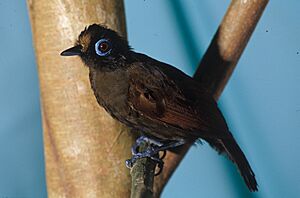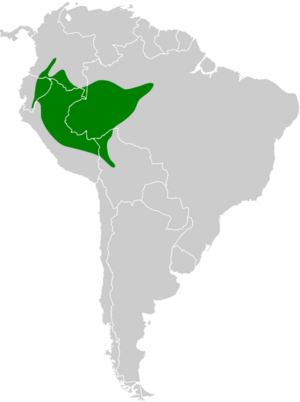Hairy-crested antbird facts for kids
Quick facts for kids Hairy-crested antbird |
|
|---|---|
 |
|
| Conservation status | |
| Scientific classification | |
| Genus: |
Rhegmatorhina
|
| Species: |
melanosticta
|
 |
|
The hairy-crested antbird (Rhegmatorhina melanosticta) is a type of bird known for its unique crest. It belongs to a group of birds called "typical antbirds" because they often follow army ants. You can find this bird in parts of South America, including Bolivia, Brazil, Colombia, Ecuador, and Peru.
Contents
About Its Name
The hairy-crested antbird was first described by two English scientists, Philip Sclater and Osbert Salvin, in 1880. They gave it the scientific name Pithys melanosticta. Later, an American scientist named Robert Ridgway put it into its current group, Rhegmatorhina.
The scientific name melanosticta comes from ancient Greek words. Melas means "black," and stiktos means "spotted." So, the name means "black-spotted," which describes some of its features.
Scientists recognize four main types, or subspecies, of the hairy-crested antbird:
- R. m. melanosticta
- R. m. brunneiceps
- R. m. purusiana
- R. m. badia
Some scientists think that R. m. brunneiceps might even be a separate species on its own!
What It Looks Like
The hairy-crested antbird is about 14 to 15 cm (5.5 to 5.9 in) long. That's about the length of a small ruler. It weighs around 29 to 33 g (1.0 to 1.2 oz), which is like a few pieces of candy.
Both male and female adult birds have a cool, bushy crest on their heads. They also have a large, pale bluish-white ring of bare skin around their eyes.
- Adult males of the most common type (R. m. melanosticta) have an olive-gray crest. Their back, wings, and tail are olive-brown. Their face and throat are black, and their belly is dark olive-brown.
- Adult females look similar to males, but they have short black bars with reddish-brown edges on their upper back and wing feathers.
- Younger males don't have a crest. Their head is blackish, and their body colors are more like the adult females.
Other subspecies have slightly different colors. For example, R. m. brunneiceps is more reddish-brown, and R. m. purusiana and R. m. badia are generally paler.
Where It Lives
The hairy-crested antbird lives in several countries in South America:
- R. m. melanosticta is found in southern Colombia, eastern Ecuador, and northeastern Peru.
- R. m. brunneiceps lives in eastern Peru, south of the Marañón River.
- R. m. purusiana is found in eastern Peru and western Brazil.
- R. m. badia lives in southeastern Peru, northwestern Bolivia, and southwestern Brazil.
These birds mostly live in the lower parts (understorey) of humid evergreen forests. These are forests where trees stay green all year. They can also be found in areas where the forest changes from dry to wet. They live at different heights, up to 1,000 m (3,300 ft) in Colombia and even higher in Peru.
Behavior
Movement
Scientists believe that the hairy-crested antbird stays in the same area all year round. It doesn't migrate.
Feeding
The hairy-crested antbird is an "obligate ant follower." This means it always follows swarms of army ants to find food. As the army ants march, they scare insects and other small creatures out of hiding. The antbirds then catch these fleeing arthropods (like spiders and insects).
They usually hunt alone, in pairs, or in family groups. They perch close to the ground, about 1 m (3 ft) high, and then quickly fly or pounce down to grab their prey. Sometimes, several family groups will gather around one ant swarm. Hairy-crested antbirds are stronger than smaller antbirds, but bigger birds like woodcreepers can push them away from the food.
Reproduction
In Peru, the hairy-crested antbird's breeding season is from at least September to December. We don't know much about their breeding times in other places.
Their nests are shaped like cups or shallow beds, often made from palm leaves. They place these nests on top of tree stumps or inside tree holes. A female usually lays two eggs. The eggs are pinkish with brown or maroon spots and streaks. Once the eggs hatch, the young birds stay in the nest for about 14 days before they are ready to fly.
Vocalization
The hairy-crested antbird has an interesting song. Some people describe it as a "slow series" that starts with high, sharp, flute-like notes and then goes down to longer, grating notes. Others say it sounds like "wheeeyr, wheer-wheer-wheer-wheer" with a whistling, slightly nasal sound that goes down in pitch. Their calls include a harsh, vibrating "chirr" and a quick "chip."
Status
The IUCN (International Union for Conservation of Nature) has listed the hairy-crested antbird as a species of "Least Concern." This means that, for now, it is not considered to be in danger of disappearing.
It lives across a very large area. While its exact population size isn't known, scientists believe the number of these birds might be slowly decreasing. However, there are no immediate major threats to them.
Even though it's generally considered uncommon, it lives in several large protected areas managed by governments and in private nature preserves. There are also many large areas of untouched forest where these birds can live safely.


